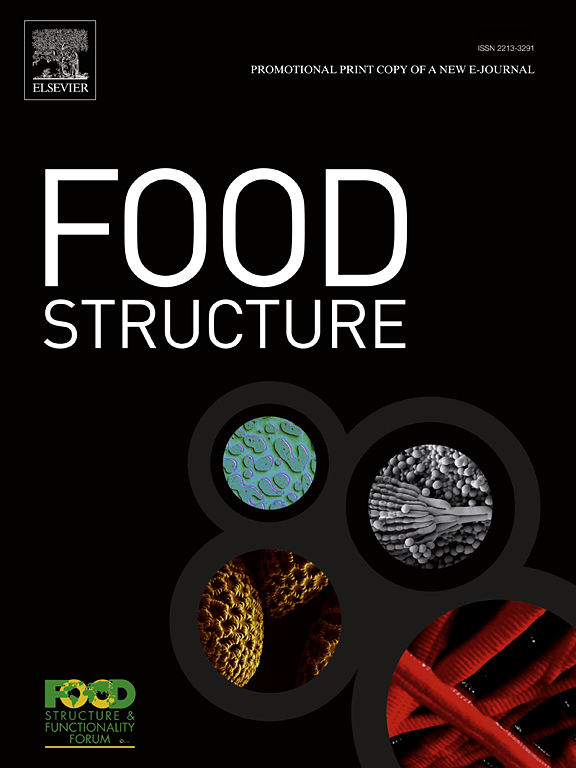淀粉增强加工马苏里拉奶酪微观结构、流变学和功能特性的协同效应
IF 5.9
3区 农林科学
Q1 FOOD SCIENCE & TECHNOLOGY
引用次数: 0
摘要
为探索糊化法改善干酪质构的可行性,从扫描电镜(SEM)、共聚焦激光扫描显微镜(CLSM)、质构分析(TPA)、流变学特性、油滴大小分布和熔融拉伸功能等方面研究了马铃薯淀粉(POS)、糯米淀粉(GRS)和木薯淀粉(TS)对马苏里拉奶酪(PMC)冷却后品质特性的影响。结果表明,淀粉的加入增强了蛋白质对脂肪的乳化能力,同时导致了少量大尺寸油滴的形成。PMC的硬度显著提高,含GRS的PMC (PMC-GRS)比含其他淀粉的PMC更软。当对照组(PMC- cg)、含POS (PMC-POS)、含grs (PMC- grs)、含TS (PMC-TS)的熔融温度分别为60.55℃、90℃、73.42℃和77.02℃时,PMC的粘弹性和熔融温度均有所提高,反复加热或长期加热后,淀粉可防止PMC过硬化;淀粉降低了PMC的熔融性,同时提高了其在室温下的拉伸性,其中PMC- grs表现出最明显的效果。PMC- POS、PMC- grs和PMC- ts制备的奶酪纤维数量显著增加,纤维强度更强,不易断裂,但拉伸长度分别减少了43.42 %、7.49 %和14.86 %。综上所述,淀粉尤其是GRS可以有效提高PMC在室温下的拉伸性能,同时保持可接受的粘弹性和硬度。这些发现为改善PMC的功能特性提供了有价值的见解。本文章由计算机程序翻译,如有差异,请以英文原文为准。
Synergistic effects on microstructural, rheological and functional properties of starch-enhanced processed mozzarella cheese
To explore the feasibility of texture improvement based on gelatinization, the effect of potato starch (POS), glutinous rice starch (GRS) and tapioca starch (TS) on quality characteristics of processed mozzarella cheese (PMC) upon cooling was investigated from scanning electron microscopy (SEM), confocal laser scanning microscopy (CLSM), texture profile analysis (TPA), rheology properties, the oil droplets size distribution and melt-stretch functionality. The results showed that protein's ability to emulsify fat was enhanced due to the addition of starch whereas leading to the formation of a small amount of large-sized oil droplets. And hardness of PMC was significantly increased, with PMC containing GRS (PMC-GRS) being softer than those with other starches. The viscoelasticity and melting temperature of PMC were increased where the melting temperature of the control group (PMC-CG), PMC containing POS (PMC-POS), PMC-GRS, PMC containing TS (PMC-TS) occurred at 60.55℃, 90℃, 73.42℃ and 77.02℃, respectively, and starch prevented PMC from over-hardening after repeated or long-term heating; Starch reduced PMC’s meltability while simultaneously improving its stretchability at room temperature, with PMC-GRS exhibiting the most pronounced effects. PMC- POS, PMC-GRS, PMC-TS produced a significantly higher number of cheese fibers which were more robust and less prone to break but reduced its stretch length by 43.42 %, 7.49 %, and 14.86 %, respectively. Overall, starch especially GRS can effectively enhance stretchability of PMC at room-temperature, while maintaining acceptable viscoelasticity and hardness. These findings provided valuable insights for improving the functional properties of PMC.
求助全文
通过发布文献求助,成功后即可免费获取论文全文。
去求助
来源期刊

Food Structure-Netherlands
Chemical Engineering-Bioengineering
CiteScore
7.20
自引率
0.00%
发文量
48
期刊介绍:
Food Structure is the premier international forum devoted to the publication of high-quality original research on food structure. The focus of this journal is on food structure in the context of its relationship with molecular composition, processing and macroscopic properties (e.g., shelf stability, sensory properties, etc.). Manuscripts that only report qualitative findings and micrographs and that lack sound hypothesis-driven, quantitative structure-function research are not accepted. Significance of the research findings for the food science community and/or industry must also be highlighted.
 求助内容:
求助内容: 应助结果提醒方式:
应助结果提醒方式:


